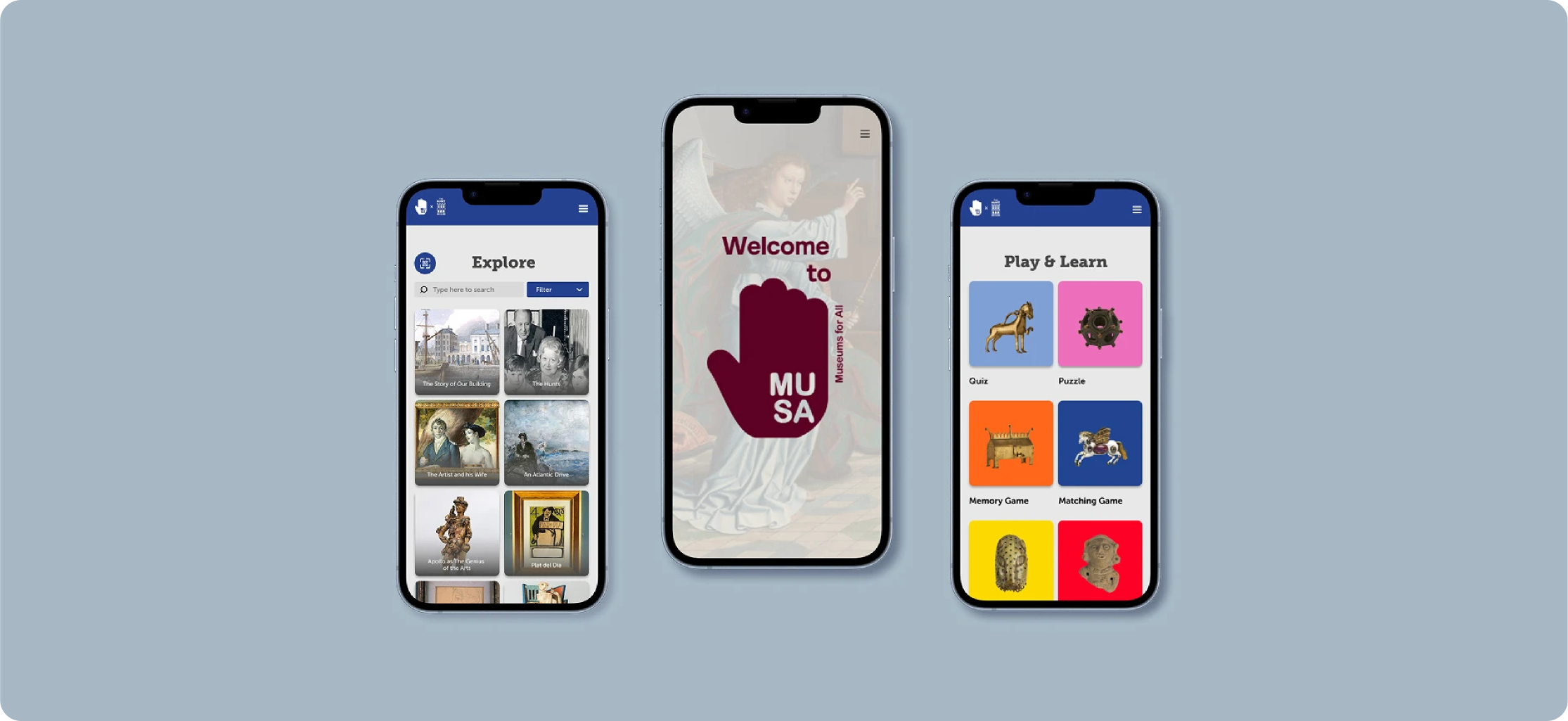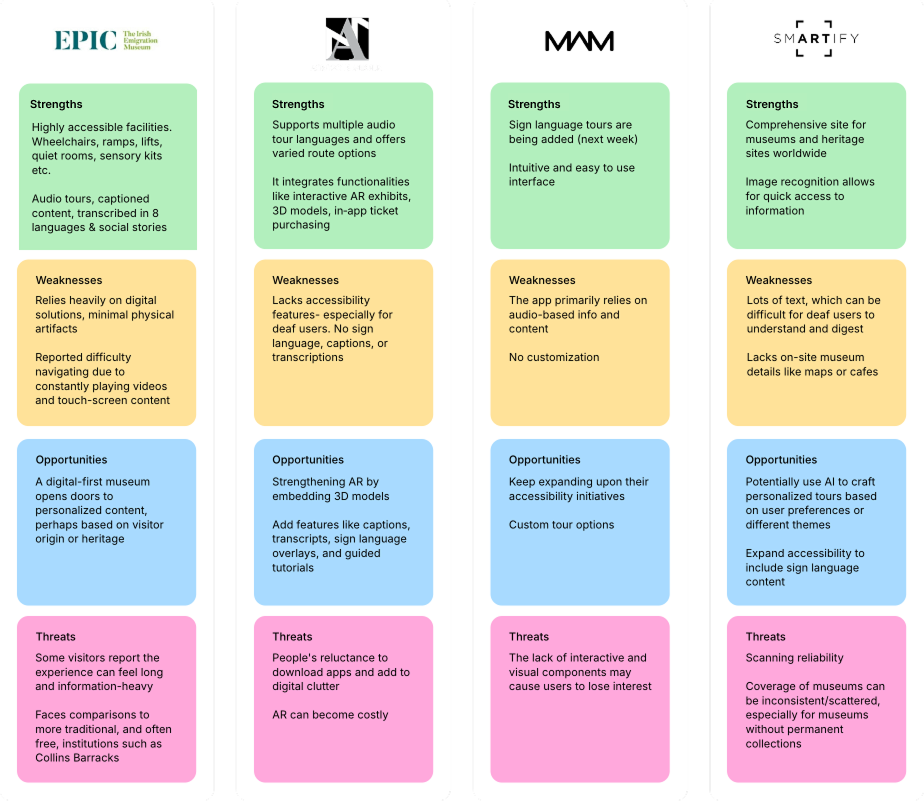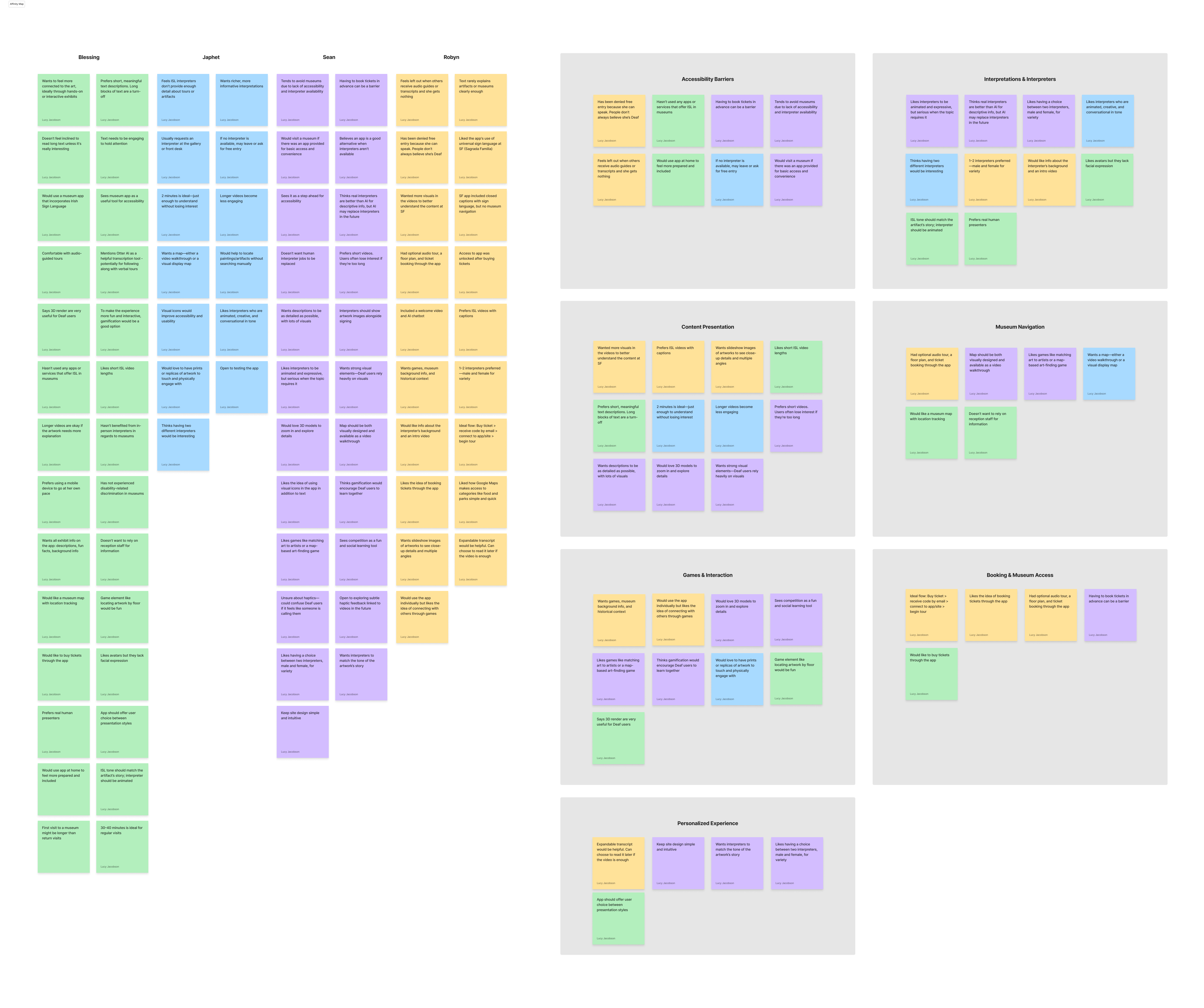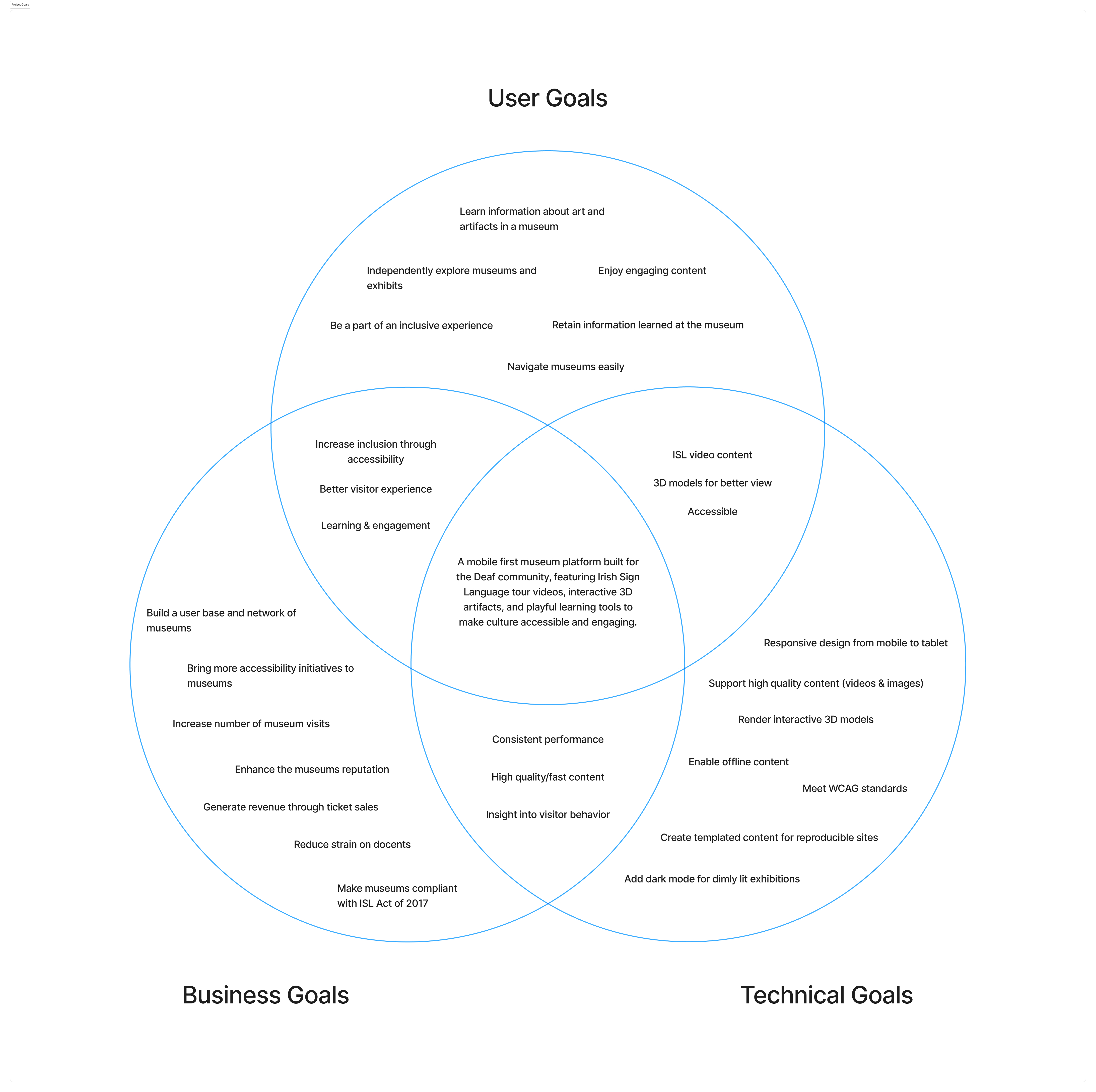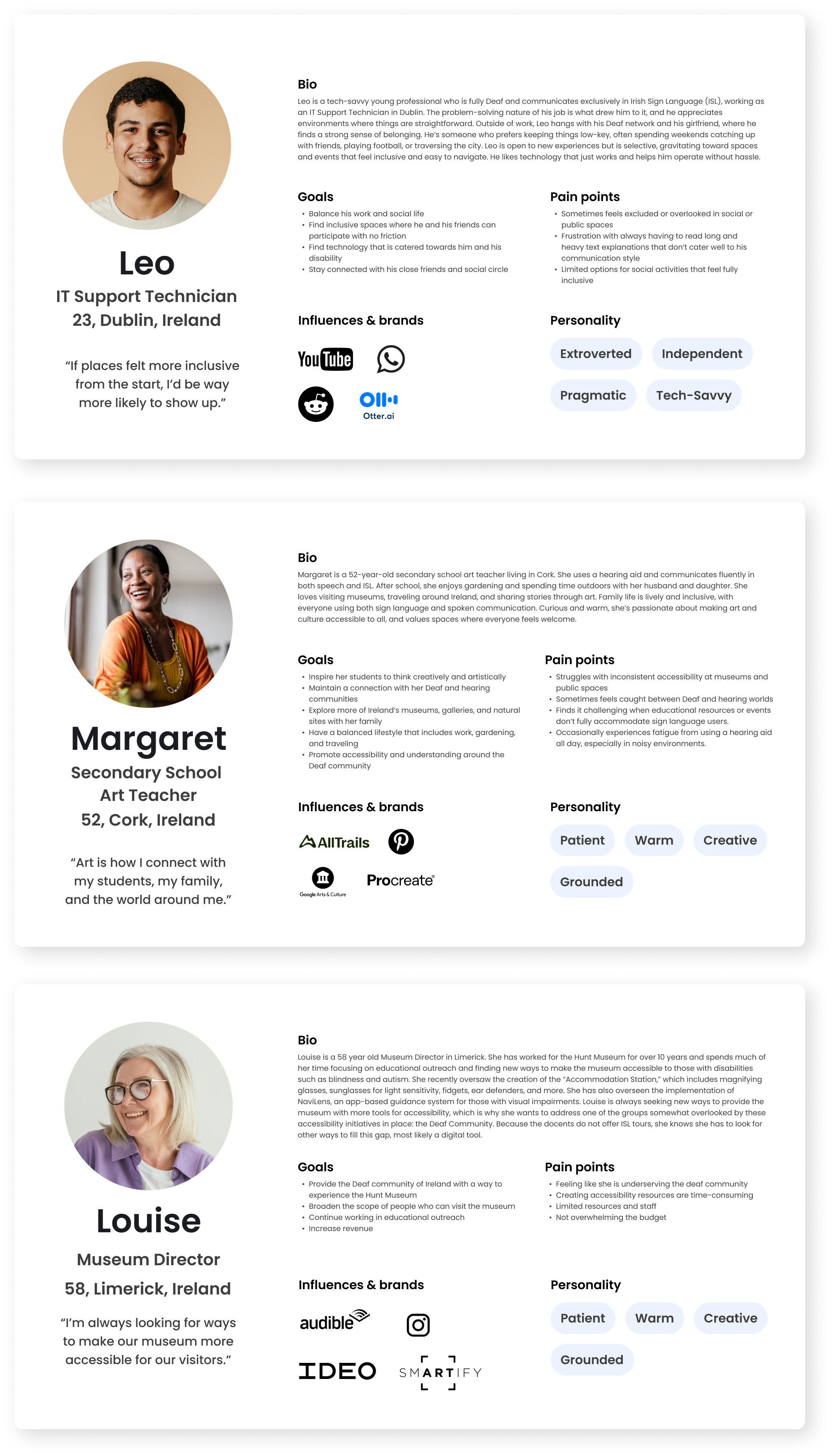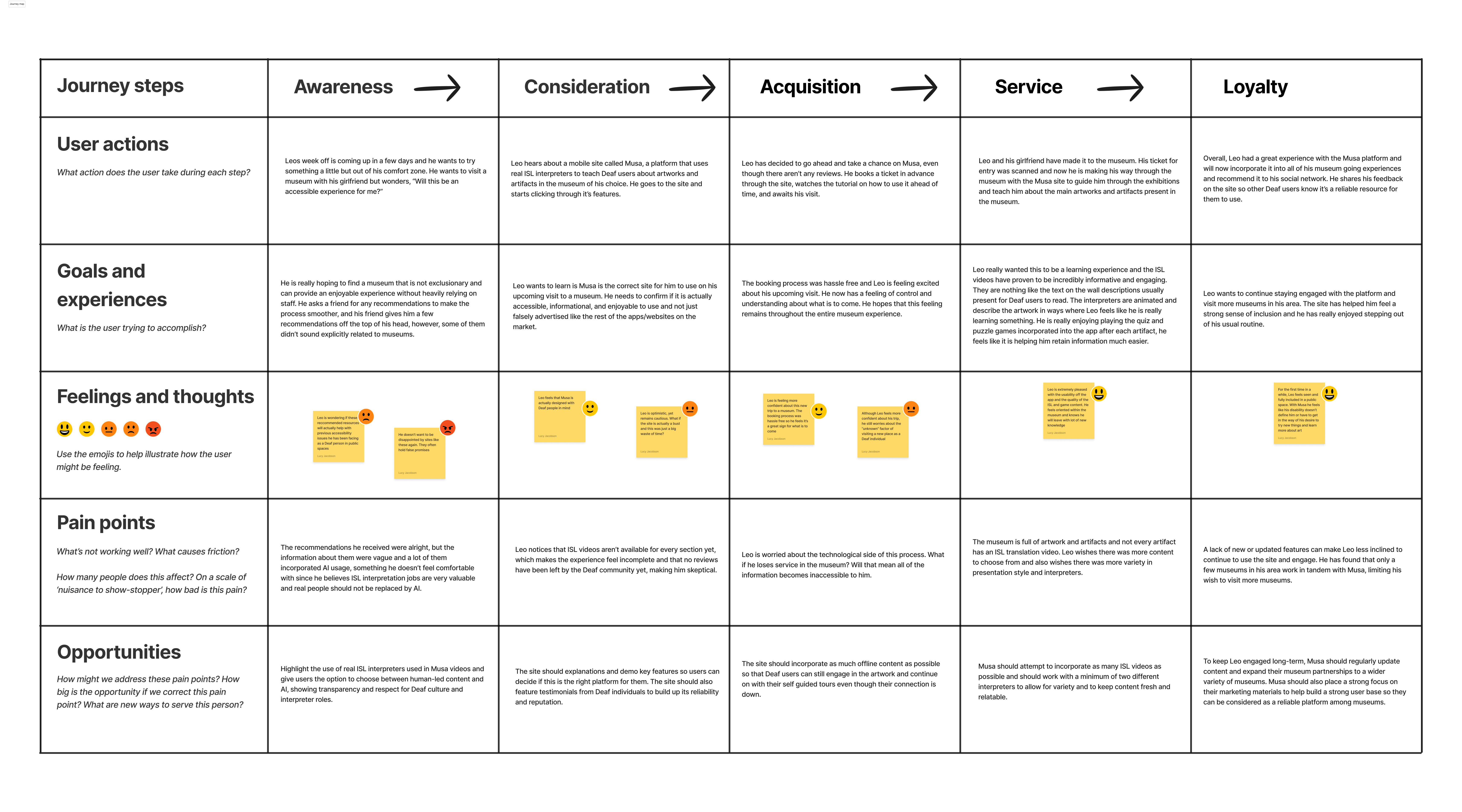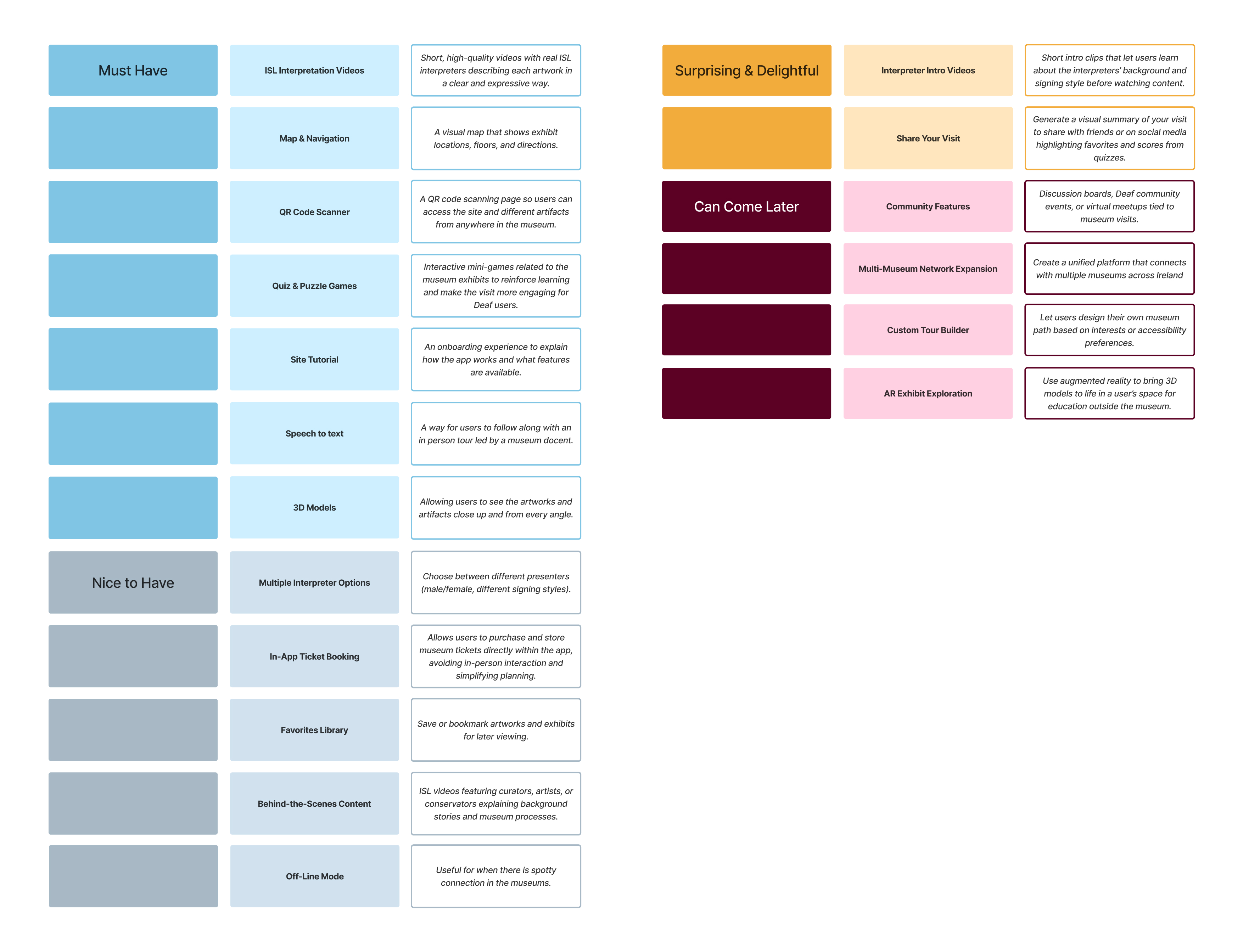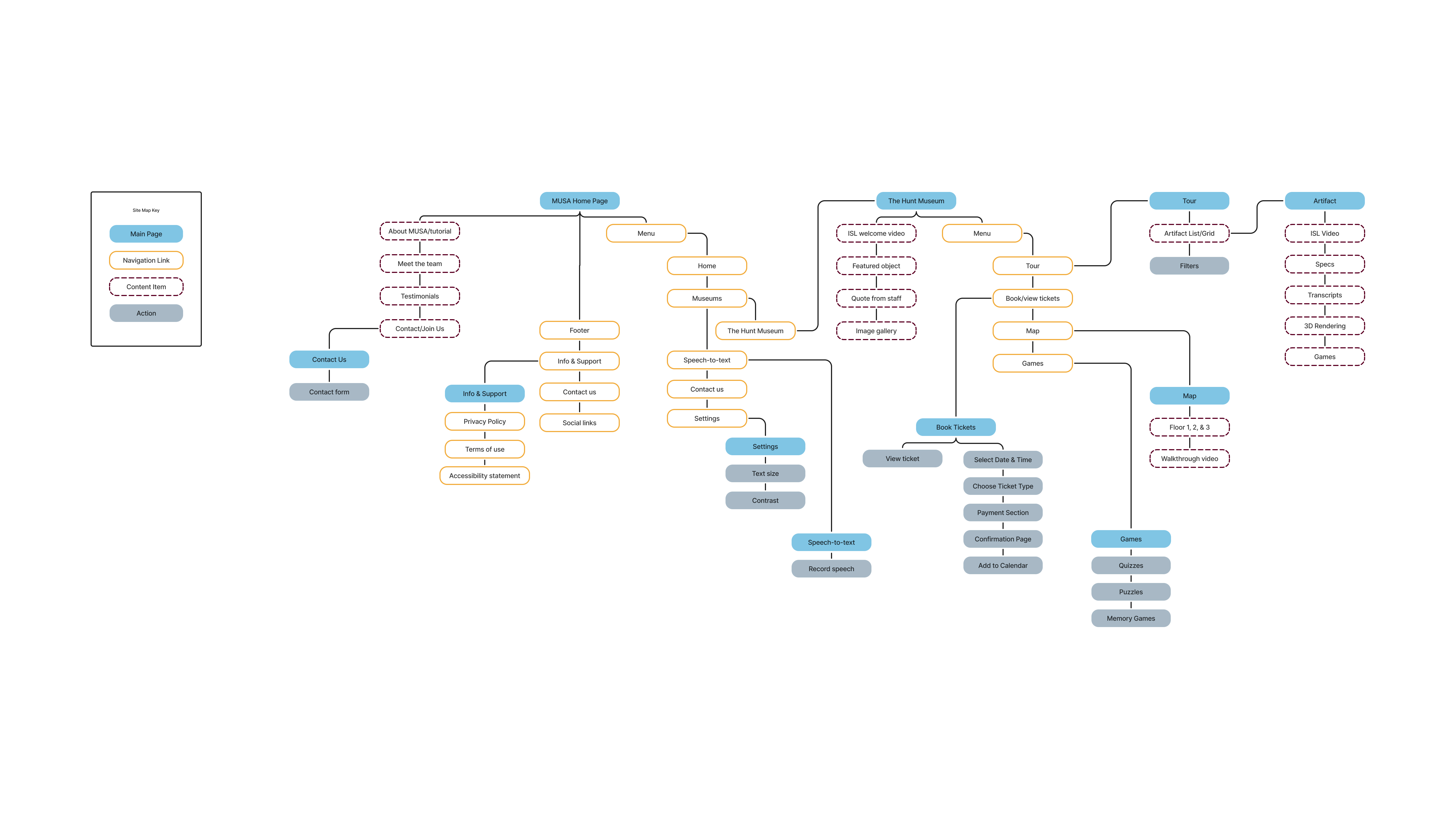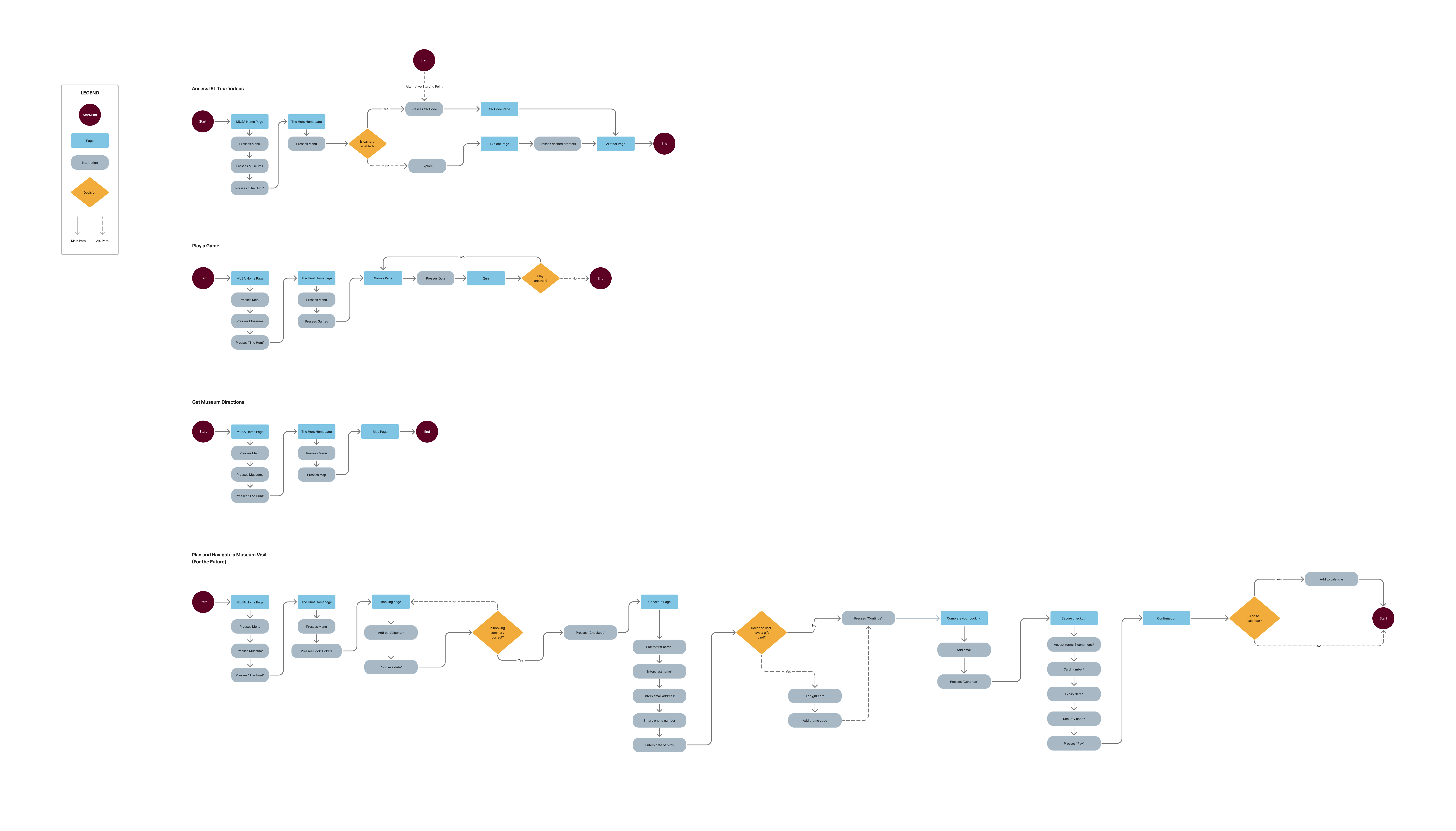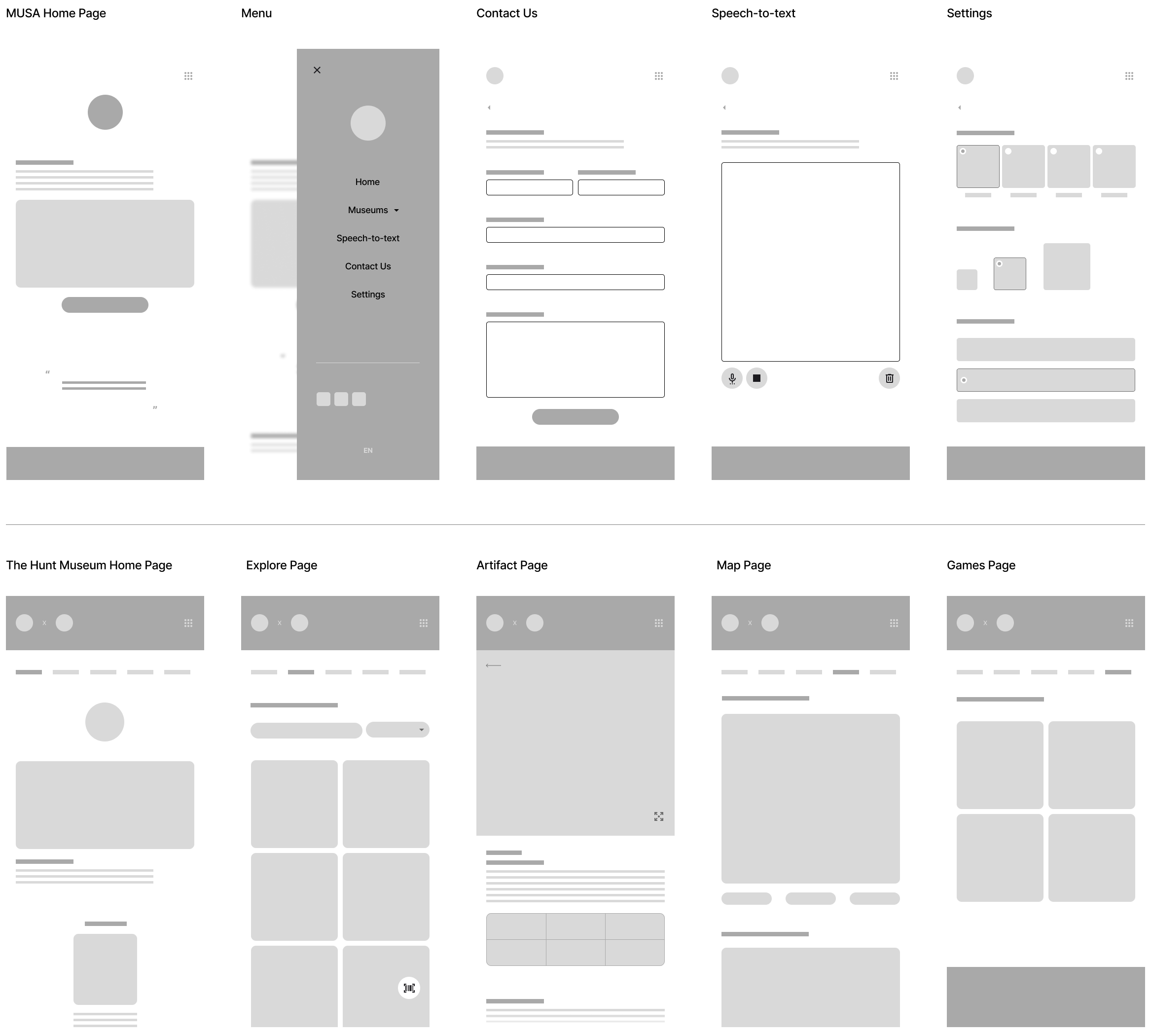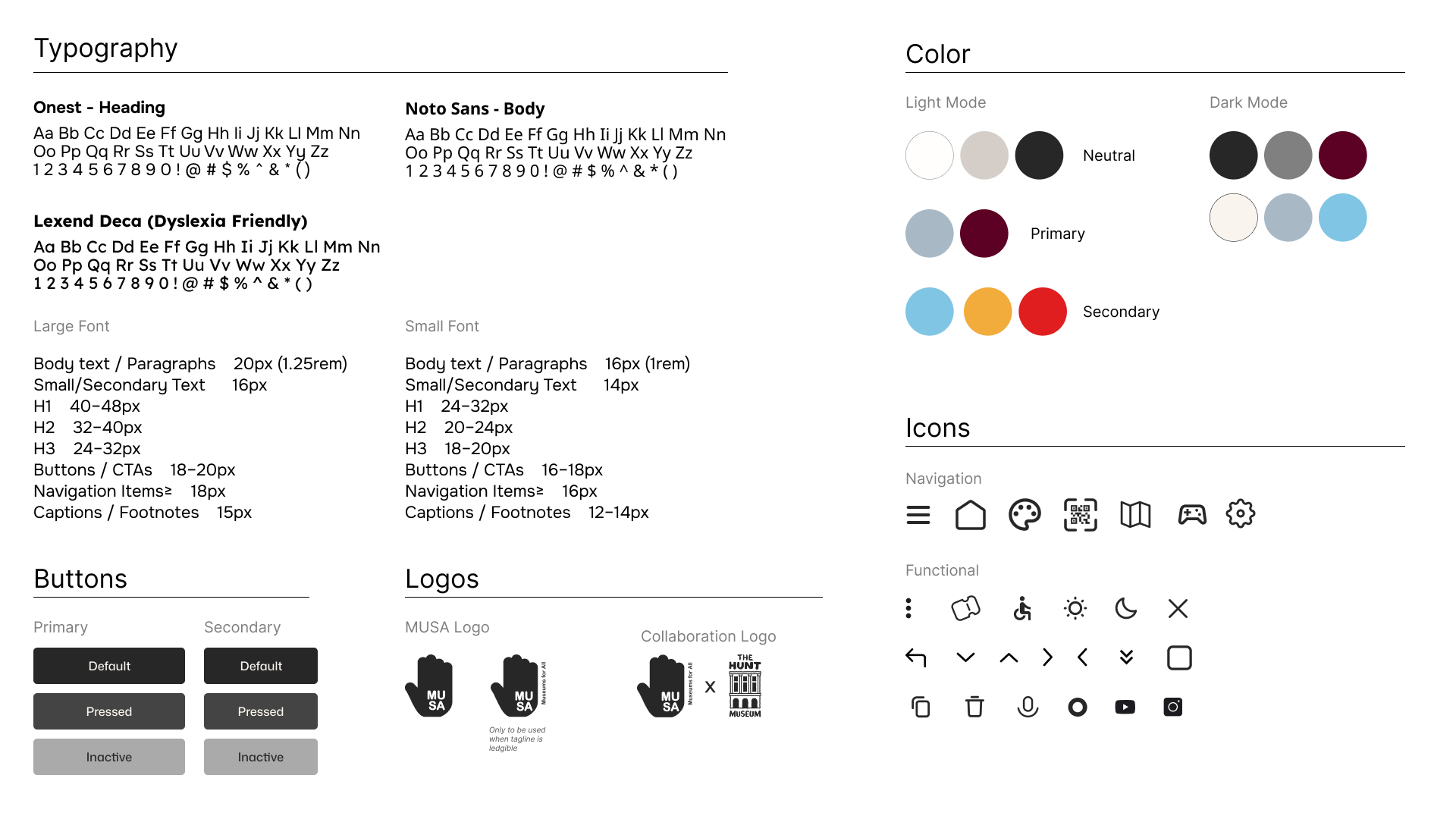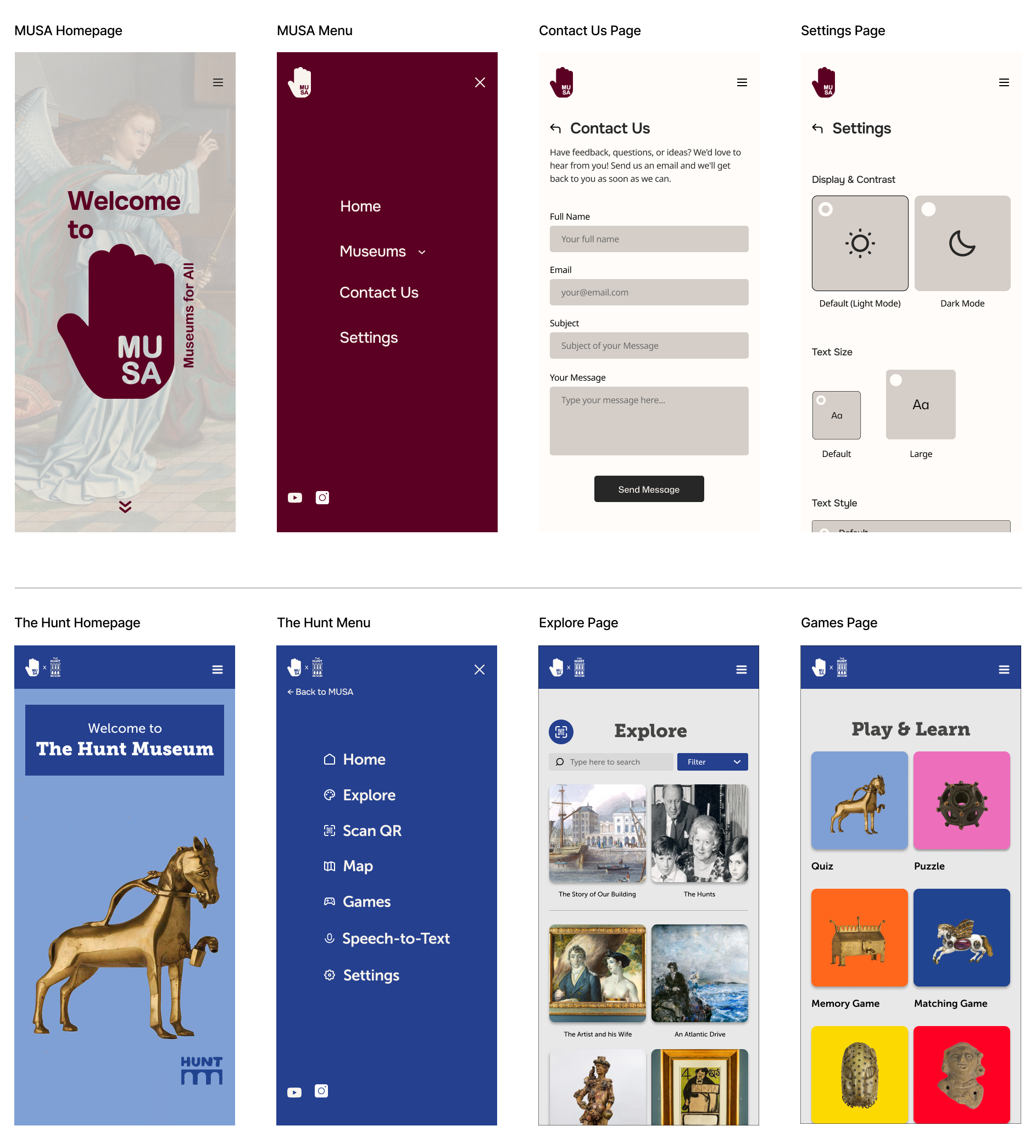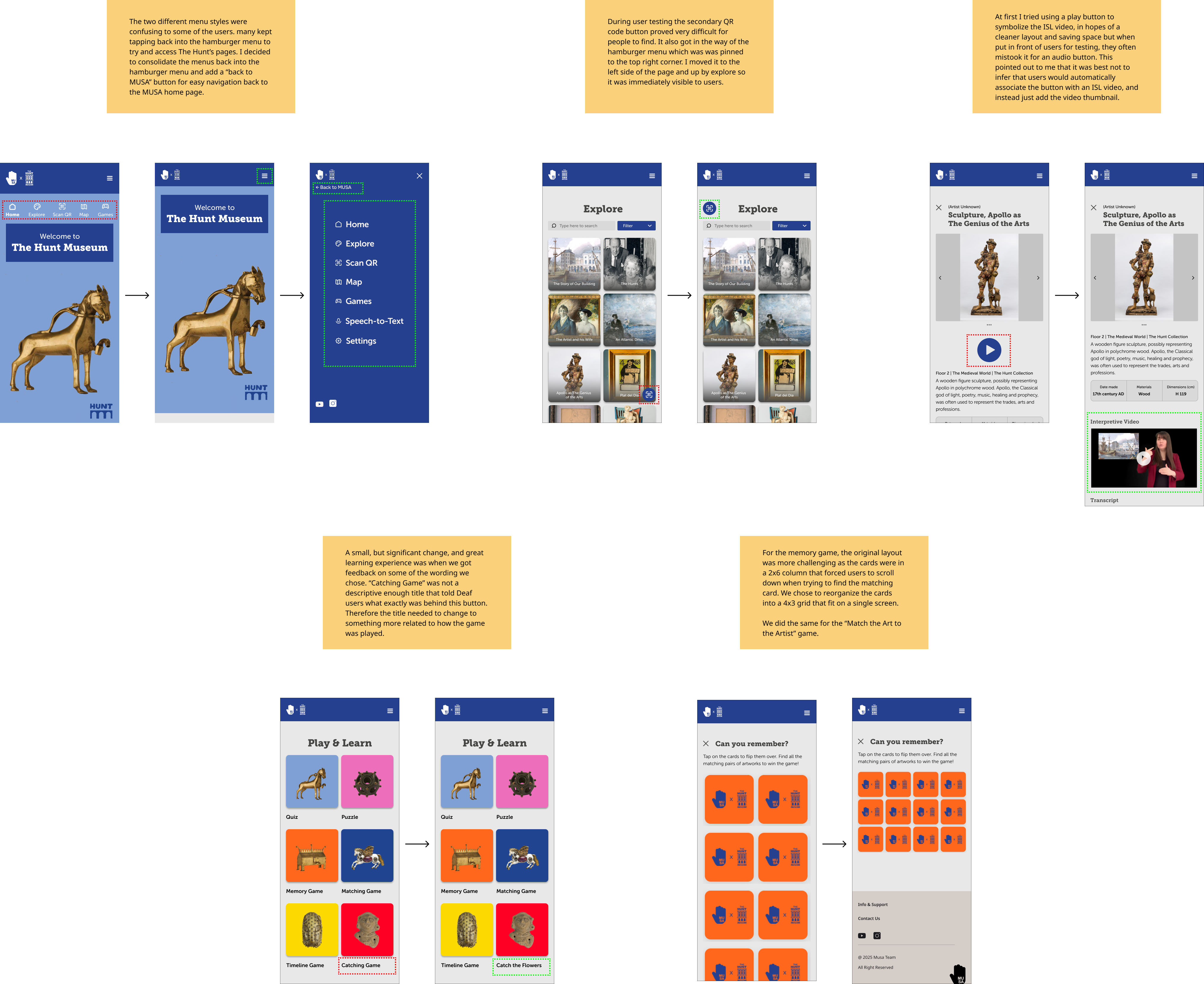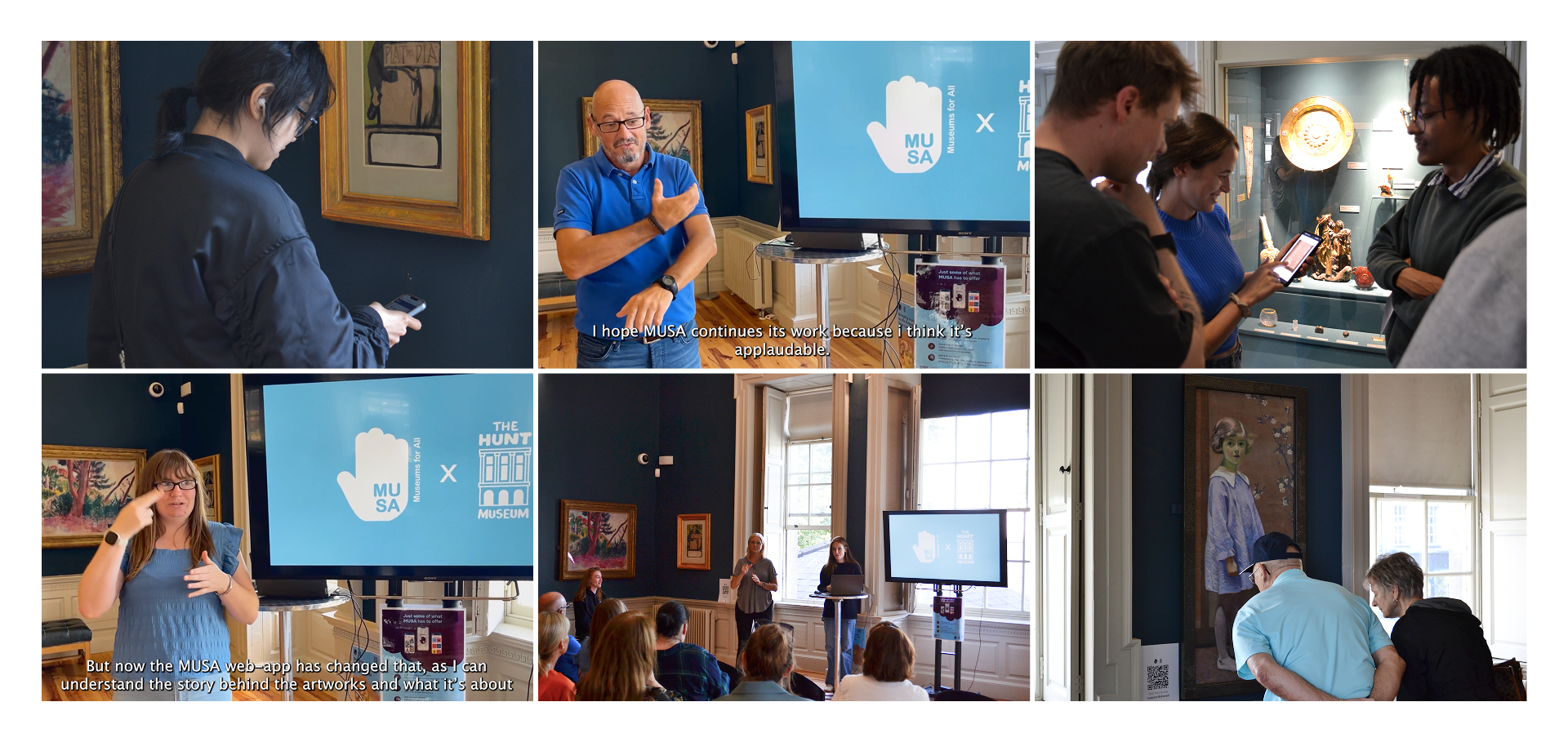MUSA
A mobile first museum platform built for the Deaf community, featuring Irish Sign Language tour videos, interactive 3D artifacts, and playful learning tools to make culture accessible and engaging.
ROLE
Product Designer
TIMELINE
3 Months
* Working on a full time schedule
PROBLEM
Deaf accessibility is often limited in Irish museum experiences
While there are no definitive statistics on the size of the Deaf community in Ireland, it’s estimated that over 103,000 people are Deaf or hard-of-hearing. Despite there being more than 200 museums across the country, accessibility for Deaf visitors is inconsistent and lacking. When accommodations do exist, they are typically inconsistent, leaving many Deaf individuals feeling overlooked. Museums tend to prioritize accessibility for visually impaired visitors through descriptive audio tours, but Deaf visitors are left to rely on written wall text, which can be inaccessible and difficult to translate. So where does this leave the Deaf community? Often excluded from fully engaging with cultural experiences.
RESEARCH METHODOLOGIES
”Nothing about us without us”
Projects I’ve worked on in the past typically involved users I could relate to, we shared common experiences, perspectives, or backgrounds. But designing for the Deaf community was a completely different experience. We don’t share a language, and we come from entirely different cultures.
What I knew from the very beginning was this: Deaf users deserve access, and they deserve intentional, thoughtful design. A phrase that guided me throughout this project was, “Nothing about us without us.” To truly understand our users, I needed to step into their world. That meant building relationships. Our project manager, Robyn, generously shared her experiences as a Deaf person and helped bridge the communication gap throughout the course of the project. We learned about our competitors and users through these methods:
01 COMPETITIVE ANALYSIS
A look at museum accessibility
I researched EPIC The Irish Emigration Museum, National Museum in Your Pocket, Musée d’Art Moderne de Paris, and Smartify to evaluate what accessibility features were, or weren’t, being offered to the Deaf community. Overall, I found that while some platforms are beginning to introduce Deaf-friendly features like transcripts and sign language content, most still lack basic accessibility such as captions, visual alternatives
Competitive Analysis
→
×
![]()
02 FOCUS GROUP
The Deaf community and their lived experiences
I spoke with 10 Deaf individuals about their experiences visiting museums, what made those visits either meaningful or frustrating. Some participants used cochlear implants, while others were profoundly Deaf and communicated primarily through Irish Sign Language. A key theme across all conversations was the widespread lack of accessibility in Irish museums. Many expressed a strong desire for independence during their visits, rather than having to rely on staff or request accommodations. Several also emphasized that true inclusion starts with a shift in mindset: the hearing community must recognize that Deaf people lead full lives, with jobs, responsibilities, and interests, and that accessibility should never be an afterthought. It should be embedded from the very beginning.
SO
"Because museums aren’t very accessible, I tend not to go at all. But that is not to say I don't want to."
RQ
"When I see people on guided tours and I have nothing, I just feel left out."
MK
"Irish Sign Language is more accessible for Deaf people than English or Irish. Large blocks of wall texts are inaccessible for some of us."
RO
"Give Deaf people a choice, subtitles, interpreters, text. Freedom of choice is important."
B
“I don’t want to have to interact with museum staff just to navigate the building and artwork. I want to be able to do it on my own.”
SYNTHESIS
Insights gathered from the focus group
Our focus group conversations revealed just how challenging it can be for Deaf individuals to visit museums. As the pain points were being discussed, I began thinking of ways to mitigate the accessibility barriers faced by our users. A common suggestion was to make museum content as visual and engaging as possible. When one of your sense is limited or completely lost, others, like sight, become even more important, and for Deaf users, visual communication is essential. The focus group gave us insight into content preferences, interpreter styles, and how users would like to interact with the platform, through features like games, quizzes and 3D models.
Affinity Map
→
KEY TAKEAWAYS
Conclusions I drew from my research
My competitive analysis, user interviews and focus group research left me with a few key insights to consider before moving onto feature selection and designing the site itself:
Interpreters should be animated, expressive, and conversational in their tone. Their facial expressions need to reflect the mood and context of the content. For instance, showing seriousness or empathy when an artwork has a somber backstory.
A detailed, easy-to-read map should be included in the app or site. Deaf users often prefer navigating independently to avoid potential communication barriers with staff. Providing this tool supports autonomy and can reduce stress during the visit.
Gamifying the museum experience, through quizzes, puzzles, or interactive elements, can make learning more enjoyable and accessible for Deaf users.
PROJECT GOALS
Defining project, user, business, and technical goals
As the research phase progressed, I identified key objectives that would define what success for the project would look like. An important goal worth noting is ensuring compliance with the ISL Act of 2017, recognizing that Irish Sign Language is Ireland's third official language. While this represents a legal requirement for museums from a business perspective, it simultaneously addresses a fundamental user need by making cultural institutions truly accessible to the deaf community.
PROJECT GOAL
Build a mobile first museum platform with and for the Deaf community, featuring Irish Sign Language tour videos, interactive 3D artifacts, and playful learning tools to make culture accessible and engaging.
USER PERSONAS
Understanding our stakeholders
To better understand our users and partners, I created three personas: two Deaf users of different ages and one representing museum leadership. This helped us address a range of communication needs and access preferences, from ISL-heavy users to those using both signed and spoken language. The museum director persona, Louise, helped us factor in institutional goals and resource limitations, reminding us that each museum's needs are different.
CUSTOMER JOURNEY MAP
The museum experience through a deaf lens
To understand what the museum experience may be like for Deaf users when using MUSA, I created a customer journey map. It highlighted how Deaf users are more likely to engage with a platform when it visibly centers their needs. For example, through the use of ISL interpreted videos and minimal reliance on text. Longterm engagement depends on continuous content updates and expanding access to more museums, because without growth and variety, user interest fades quickly.
Customer Journey Map
→
POV & HMW STATEMENT
Defining the museum accessibility challenge
I distilled the patterns found in my research regarding accessibility barriers faced by the Deaf community in museums into a clear POV and HMW statement. These provided a focused reference that helped me keep my ideas aligned throughout the project.
POV
As someone who is Deaf or hard of hearing, I need accessible and engaging ways to experience museum exhibits, without having to rely on long written text or hope that a sign language tour is available. Right now, most museums don’t fully meet my communication preferences or comprehension needs.
HMW
How might we create an accessible and engaging museum experience for people with hearing disabilities that doesn’t rely on lengthy written explanations or unavailable sign language tours?
FEATURE SELECTION
Key features that will make up the MUSA site
Based on conversations with users, I put together a list of features for the MUSA site, organizing them by priority. Due to time constraints, we couldn’t implement everything, but we successfully focused on and delivered all the “Must Have” features.
Feature Set
→
SITE MAP
Architecting the experience
I created the site map to help both myself and our full stack developer visualize how the screens would be organized and what content belonged on each page. During this process, I realized the MUSA site needed to include sub-sites for individual museums. For example, the main MUSA site has its own branding, and within it are the partner museums we’re working with. In this case, you’ll see our partner museum, the Hunt, listed under the “Museums” menu.
Site Map
→
USER FLOWS
Designing flows for ISL tours, games, and directions
I created 3 user flows focused on the main features of the MUSA site: ISL tours, games, and museum directions. I also included a flow for a future ticket booking feature, which we decided not to implement this time due to time constraints and concerns around handling payment information. This phase helped me finalize how the Hunt museum page would sit within the MUSA site, and how QR codes could simplify access to specific objects and artifacts.
User Flows
→
LOW-FIDELITY WIREFRAMES
Blocking out the main pages
When designing the low-fidelity wireframes, I focused on how users would move between the MUSA and Hunt Museum pages. At this stage, it made the most sense to place the MUSA pages within a hamburger menu, while keeping a traditional top navigation bar for the Hunt Museum pages. I felt this made a clear distinction between the two sections.
Low-Fidelity Wireframes
→
BRANDING
Creating and blending brands
For the branding, I drew inspiration from the colors of the Deaf flag, along with some iconic tones from the Bauhaus movement. Since this project brings together the Deaf community and the world of art, the combination just felt right. Earlier on, the Hunt Museum shared their brand guidelines, so I used those to apply their visual style across the wireframes. I also kept their main website open as a reference throughout the process to make sure my designs stayed true to their existing brand.
Branding
→
HIGH-FIDELITY WIREFRAMES
Putting it all together
I collaborated with our content lead, Kiera, to implement the content and focused on finding the most effective way to present information about each artifact and artwork. The Explore page required some back-and-forth with stakeholders at the Hunt Museum, as several objects belong to different collections, like the Contemporary Irish Ceramics collection. They wanted to make sure it was clear that the museum is made up of multiple collections. To address this, I designed a filter button that allows users to sort pieces by collection, as well as by floor and artifact type. I also added a subtle dividing line to separate the introductory videos about the museum and its founders from the rest of the artwork, creating a clearer distinction between the two sections.
High-Fidelity Wireframes
→
TESTING
Putting the design in front of people
I user tested the site with 10 people. Six of the users were Deaf or hard of hearing, while the other four were not. Since the site can serve both groups, it felt important to gather feedback from a range of users. I asked participants to complete four main tasks: navigate to the Hunt Museum’s site, locate a specific artwork, use the QR code feature, and find the games page. To evaluate how well they performed each task, I timed them, asked them to talk me through their process, and had them rate the difficulty on a scale from 1 to 5. I also collected general feedback throughout the sessions. Some of the conversations were more open-ended. I encouraged users to explore the site freely, play the games and point out any areas of friction.
Here’s a look at some of the feedback I received:
DP
"The different menus on the MUSA and Hunt pages are confusing. I keep expecting to find Hunt-related content in the hamburger menu."
SO
"What does "Catching Game" mean? It may be helpful to other Deaf users if the game titles are as descriptive as possible so people know what they're about to play."
JW
"The second QR code you have nested in the bottom of the explore page was nearly impossible for me to see."
JO
"Could you add a button to the hamburger menu that takes you directly back to the MUSA home page?"
RL
"Is this play button supposed represent the ISL videos?"
ITERATIONS
Changes made based on feedback
Based on the feedback from user testing, I made five key changes. The first was consolidating the navigation menus. Now, when users are on the MUSA site, they see the MUSA-specific menu. When they switch to the Hunt Museum site, they get a different menu with clear options to explore the collection, view the map, and access the games page, along with a clear button to return to the MUSA site.
I also worked with our content lead to review and adjust the copy across the site. We made sure everything was written in A2-level English to make the content more accessible and easier to understand for our Deaf users.
Iterations
→
LAUNCH DAY
The official unveiling of MUSA at the Hunt Museum
After making the major changes, we teamed up with our partners at the Hunt Museum to plan a launch day during Cultural Heritage Week in Ireland. We placed QR codes around the museum next to their corresponding objects and welcomed the first official users of MUSA. It was a fantastic day. The turnout was strong and the feedback was even better. Everyone was excited that we chose to roll out the project in Limerick, especially since most accessibility initiatives for the Deaf community usually start in Dublin. One gentleman shared his hope that we would continue adding more objects to the site, believing it could benefit from a larger collection of artwork. We assured him that expanding the site would be our top priority once we secured additional funding.
GOING FORWARD
The next steps for MUSA
After the launch, the Hunt Museum’s Director and CEO met with representatives from the National Gallery in Dublin to discuss our project and the possibility of implementing it in their museum. Our team is excited about the idea of continuing to build MUSA and partnering with other museums and cultural institutions in the future. This is how we’d like to do it:
PHASE 2
Add more artwork to the Hunt Museum’s ISL tour
We plan to continue working with our stakeholders at the Hunt Museum to add more artwork to the existing ISL tour. We’re also hoping to bring in at least one additional ISL interpreter to add more variety and representation across the site.
Introduce different sign language options on the MUSA site
Because of its location, the Hunt Museum receives many visitors from the UK, including Deaf users who communicate using BSL. To stay true to our mission of "Museums for All," it's important that we include more than just one form of sign language.
Add "Nice to have" features
Add more features like multiple interpreter options, in-app ticket booking, and offline mode to improve the overall experience.
PHASE 3
Expand museum partnerships
We want to grow MUSA by partnering with more museums across Ireland, and possibly expand to the US, bringing accessible tours to a wider audience.
↑
